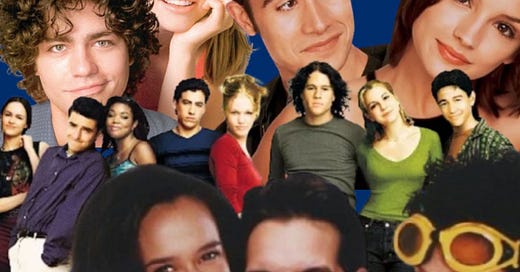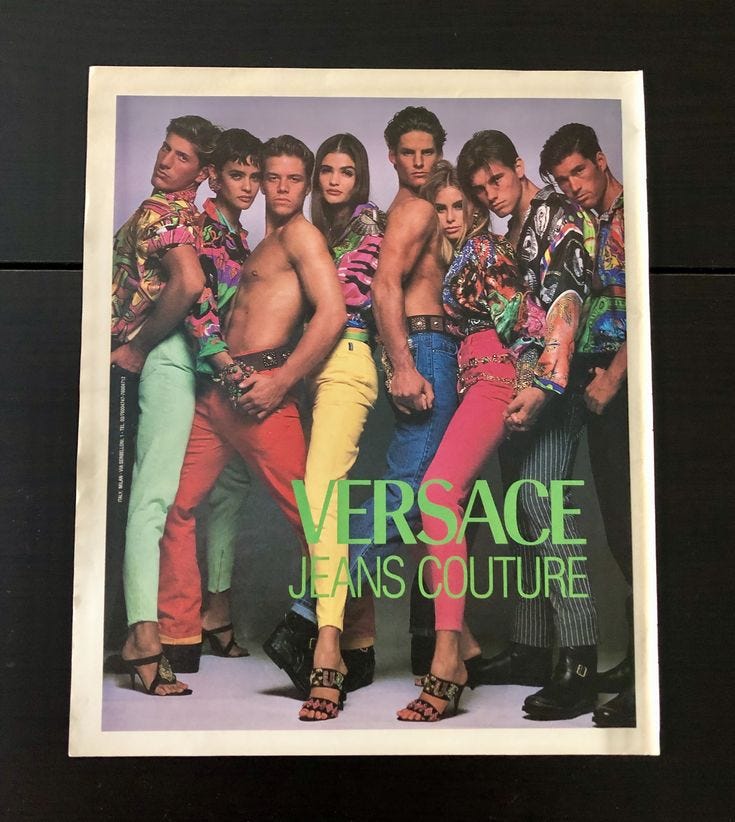You're a Virgin Who Can't Drive: Red Jeans by Versace
It’s no wonder Millennials are entitled— they used to call us “Generation Y,” and from TRL to Teen Beat to an endless fountain of high school comedies, we grew up feeling affirmed that the entire world revolved around us. I recognize that my specific 12-year old cultural universe was tailor-made for tweens because I tailor-made it—the only media I consumed was teen-oriented and I never sought out entertainment for old people. Even so, the flurry of teen movies released between 1995 and 1998 pointed to a broader trend toward youth culture, driven by a blend of demand and economics. High school comedies were cheap to make, fast to shoot, and while a few made studios a ton of money, they served as important vehicles for rising talent with legacies that lived on at Blockbuster. An unintended consequence? Kids like me grew up to be content creators, convinced our lives were worth watching (see: Nose Candy).
The majority of teen movies released between 1995 and 1998 were rated PG-13—a new studio standard to maximize $$$ by expanding audience reach. The strategy worked perfectly on me; I was too young to party and already spending entire weekends at the movies in massive groups of kids. In 7th grade I watched and rewatched so many weekend matinees of She’s All That that my mom eventually refused me the five dollars I needed for a ticket, asking simply: “Why?”
The answer was simple: these films were designed to light up my Gen Y dopamine receptors. Studios timed their four-week shoots around cable TV schedules to capture network stars like Sarah Michelle Gellar and Jennifer Love Hewitt—the same ones I’d grown up watching on Buffy and Party of Five. The Dotcom bubble had yet to burst and the American economy was stronger than it had been in decades, so companies looked towards teens as a rapt demographic with unlimited time, newfound cash, and pitifully low artistic standards.
The film industry was the most visible example, but fashion also paid attention to teens, with diffusion lines that made their aspirational labels accessible to kids at the mall. Calvin Klein had launched underwear in 1982, with a Riefenstahl-coded campaign featuring full-grown Olympian Tomás Hintnaus. Ten years later, the brand turned to 18 and 20-year old Kate Moss and Mark Wahlberg to sell their cotton briefs. Calvin Klein’s emphasis on licensing during the 1990s made his brand ubiquitous at the Del Amo Mall, my house of teenage worship, which also hosted an Armani Exchange (A|X), DKNY, and Polo Ralph Lauren boutique.
In 1989, Gianni Versace launched Versace Jeans Couture in an attempt to expand Versace offerings to a youth audience. It was a more elevated diffusion line than the ones I shopped at the Torrance mall, carried instead at the same luxury department stores in Beverly Hills that sold Versace full-price. I always associate Versace Jeans with Absolutely Fabulous because its Miami-coded tackiness felt like a style template for Edina— insanely loud and garish, with enormous labels anywhere they’d fit.
An aesthetic adopted by the Spice Girls, Cher Horowitz, and Romy and Michele, Versace Jeans was coveted by all my favorite divas and I saved my allowance for zebra-print jeans and a massive silver belt buckle in an attempt to approximate the look. On a sponsored pilgrimage to TJ Maxx in search of printed denim, I instead found a dented red aluminum canister emblazoned with the Versace logo. Marked at eight dollars on clearance I begged my mom to get what I assumed was a… pencil case? Cookie jar? Stash box? “It’s for perfume!” she explained, plunking a transparent red bottle off the shelf and popping it inside. It was at this moment that perfume became my entire personality.
Versace Red Jeans was launched in 1994 as a pour femme accompaniment to Blue Jeans for men. “Blue” is a broad fragrance category, but you’ll know it when you smell it— freshies like D&G Light Blue, aquatics like Cool Water, and aromatics like Le Bleu de Chanel are all so-named because they conjure a sinus-clearing masculine breeze. If blue was for boys then red was the equivalent for girls, so Red Jeans perfumer Jean-Pierre Bethouart created a powdery apricot musk that smelled like ethanol and dry shampoo. It turns out the metal canister I first fell in love with was a cheap rip-off of Jean Paul Gaultier’s Classique tin can packaging, brought even further downmarket by Liz Claiborne’s Curve in 1996. All three fragrances run across the same fruity, powdery spectrum, but Versace’s charm comes from a girls’ locker room accord that felt absolutely perfect for middle school.
Juicy and jejune, Red Jeans lived on my vanity next to a blue bottle of Curve (Rite Aid, $15.99) and a prized bottle of Candies (JCPenney, $24.99) by Guerlain master nose Thierry Wasser. All three perfumes smelled like Peach Crystal Light, but I favored Red Jeans, which was the least expensive but stamped with a designer label that made me feel rich.
Today, hairspray-scented Red Jeans smells exactly like Jennifer Love Hewitt in Can’t Hardly Wait, a freshly-showered talc-dusted popular girl. I’ve always been more Ethan Embry then J Love, and now that spring has sprung I’ve returned to my roots and have been rocking Red Jeans with a sweater vest and wallet chain. With its peach powder synthetic sillage it sort of smells like an aerosol Designer Imposter perfume, which feels on-brand for the Disneyland fashion simulacrum that is Versace Jeans. It gives me a headache and lasts way too long, but in the world of frou frou nichies, Red Jeans is a back-to-basics reminder that sometimes being real means smelling fake.






